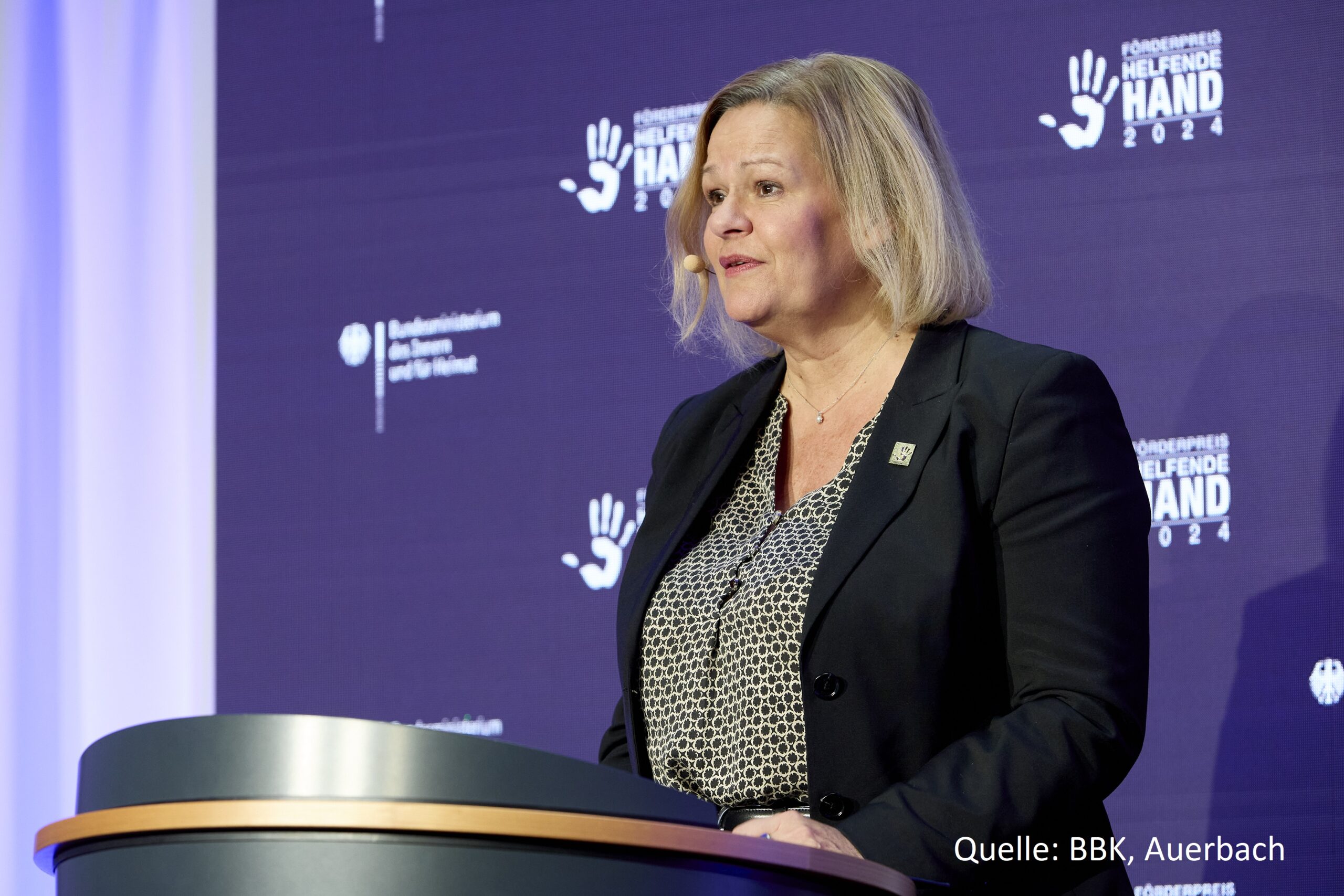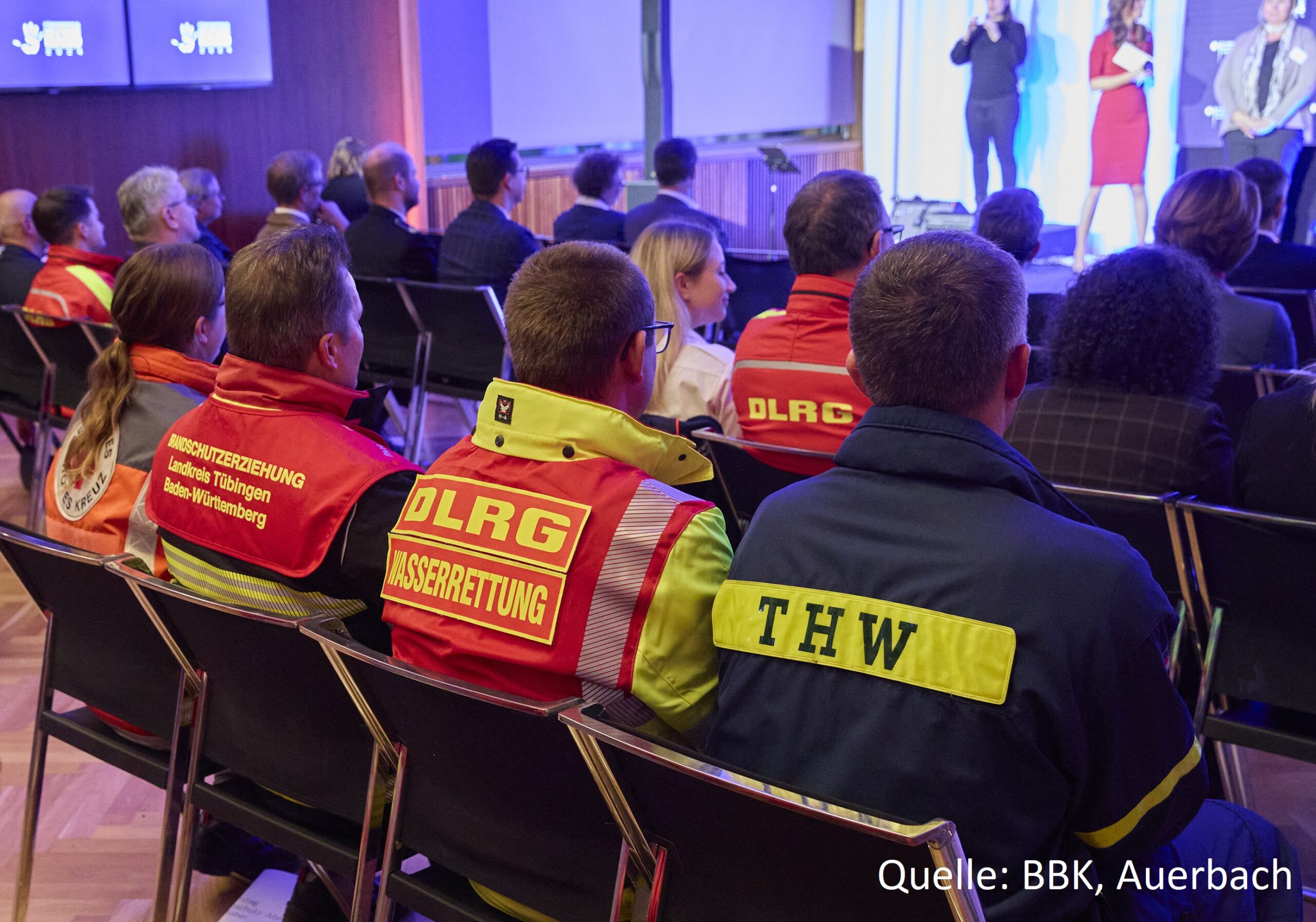13.01.2025 | Bericht
‘The Helping Hand is slowly coming of age’ – this is how Federal Minister Nancy Faeser categorised the long tradition of the 16th presentation of the “Helping Hand” award. The award was established in 2009 to honour volunteer work in the field of civil protection. A tradition which is more than just an award ceremony. The personal exchange between the nominees and the heads of the aid organisations about projects and ideas once again formed the lively setting for this year’s gala in the office building of the Federal Ministry of the Interior and Community (BMI).
With around 120 participants, the hall was packed when the Berlin based band ‘Stand Arts’ accompanied the festive part with a mix of styles ranging from bossa nova to chanson – a musical reflection of the diversity of voluntary work in civil protection. Host Susanne Schöne was already able to announce a record in her welcoming address: With 640 submissions, more projects applied this year than ever before. This initially meant a lot of work for the jury, which had the difficult task of selecting worthy nominees and ultimately award winners. Above all, however, it meant that the nominees present in the hall had already beaten hundreds of other applications so that, as Susanne Schöne put it, all those who made it to Berlin could already see themselves as winning projects before the award ceremony.

Nancy Faeser recalled the increased importance of civil protection in Germany, driven by heavy rainfall, flooding and landslides as a result of the climate crisis on the one hand and war in the centre of Europe on the other. Let this be a reminder to everyone to ‘make our country more resilient’. ‘We have felt too safe,’ said the Federal Minister, summarising the threat situation. ‘Even our strong society is vulnerable’. To counteract this, considerable investments were made e.g. in the warning system, but direct improvements for the numerous volunteers were also necessary. Some had already been implemented, for example, by taking pension entitlements into account, but also by increasing penalties for attacks on helpers. In the eyes of the Federal Minister, the annual Civil Protection Day and the Joint Civil Protection Competence Centre, supported by various stakeholders at federal and state level, are also examples of further efforts in the field of civil protection.
Cooperation as a success factor
The principle of cooperation between different organisations subsequently formed the common thread for many projects that were awarded with the Helping Hand. A conspicuous number of projects were set up jointly by several organisations. Some partnerships extended beyond the circle of traditional aid organisations. For example, the third place in the ‘Innovative concepts’ category went to the ‘Emergency bell ringing’ project, where the bell ringing of six Protestant and Catholic churches fills gaps in the local siren network and thus helps to alert the population in the event of an emergency. This was made possible by the creative cooperation between the local civil protection organisation and the church communities.

In the district of Plön, six organisations (ASB, DLRG, DRK, FFW, JUH and THW) have joined forces to introduce nursery and school children to the work of emergency service organisations. In this way, they were able to give the children and young people real-life experiences, individually tailored to the respective educational institution, from teddy bear hospitals to plaster-driving-licences. The reward for the work of the ‘Blue Light Project’ was a large number of people interested in joining the volunteer organisation – and first place in the ‘Young talent work’ category. The winner in the ‘Support for Volunteering’ category also involved a broad network: The Service Centre for Volunteering at the Würzburg District Office came up with the striking name ‘FEEL FR.E.E.’ for its collaboration with ASB, DLRG, DRK, FFW, JUH, MHD, THW and others to summarise the guiding principle of voluntary, honorary and committed work. So far, the project has motivated 570 young people to spend a school year getting a taste of the structures and working methods in the field of civil protection.
The winners of the third prize in the ‘Support for voluntary work’ category also presented a new image.
The Dormagen reservist comradeship accepted their prize for their commitment to dyke protection in a Bundeswehr field suit. A motivation for volunteers beyond the traditional civil defence and disaster control organisations to apply for the Helping Hand. The award, which was not decided by the jury but by votes cast via the website, also went to a joint project: the ‘Disaster Prevention Action Day’ at 40 schools, organised by ASB, DFV/FFW, DLRG, DRK, JUH, MHD and THW. On stage, the delighted organisers revealed the secret of their success – they had canvassed for votes from all over Baden-Württemberg.
The ceremony concluded with perhaps the most important part for many: the personal exchange from project to project in order to be inspired and make connections across regions and organisations. In some cases, initial project ideas for the next Helping Hand were already being discussed.